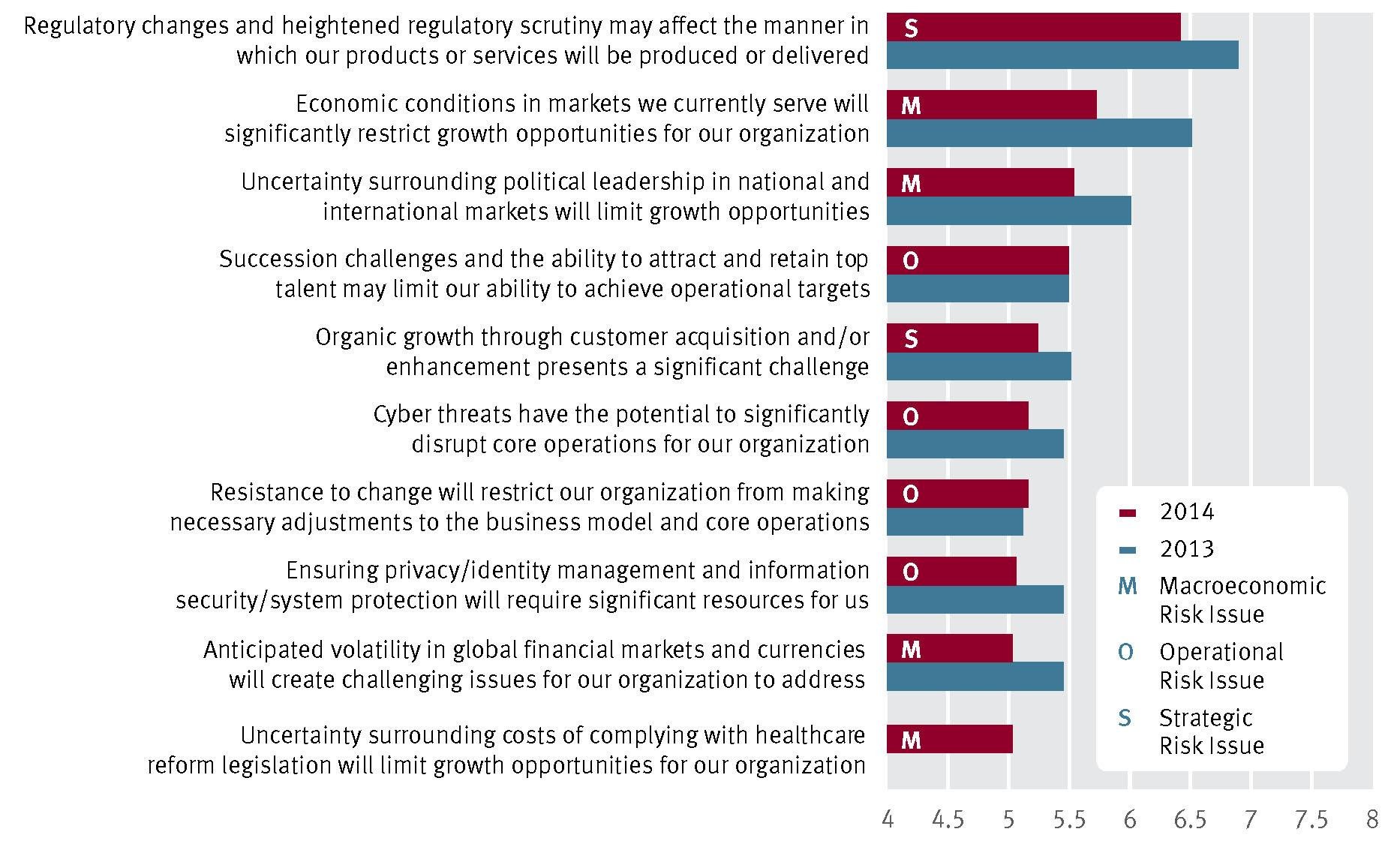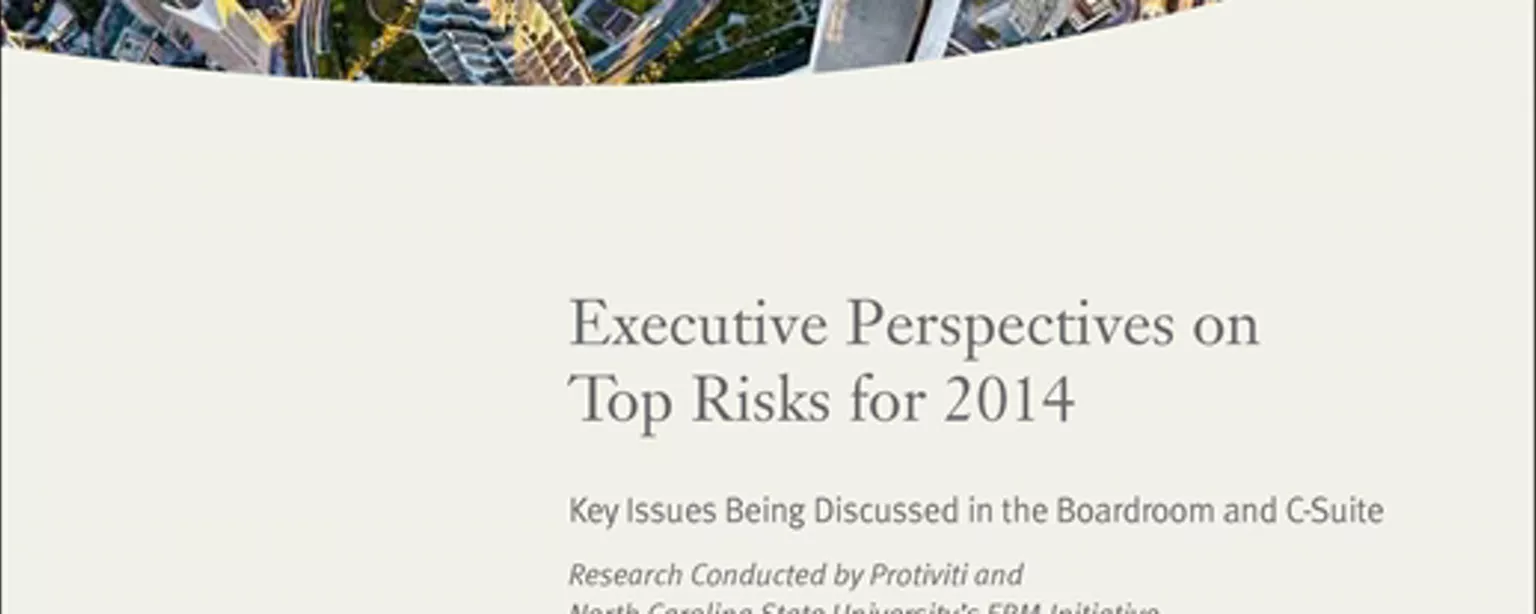Protiviti, a subsidiary of Robert Half, is a global consulting firm that helps companies solve problems in finance, technology, operations, governance, risk and internal audit. This post is adapted from our report on a survey of more than 370 board members and C-suite executives about the risks they consider top-of-mind for the coming year. The survey was conducted for the second consecutive year by North Carolina State University’s ERM Initiative and Protiviti. For more information, visit protiviti.com/toprisks.
Expectations of key stakeholders continue to be high regarding the need for greater transparency about the nature and magnitude of risks the organization faces. Pressures on boards to be effective in risk oversight lead to continued calls for management to design and implement effective risk management processes to ensure operational and functional leaders identify, assess, understand and manage the organization’s key risk exposures.
According to our study, the top-risk concerns for 2014 largely mirror our survey findings for 2013. Board members and executives continue to be concerned about risks that could impact business growth and health, but there was a slight reduction in their perceptions of the severity of most risks in 2014 relative to 2013.
Of note, boards of directors seem to view the business environment as more risky than management does. Directors rated four of the top five risks as “Significant,” more than any of their executive counterparts. This may be due to the fact that boards of directors tend to focus more on strategic issues, and the issues they rated as higher were all in the strategic category. We intend to look at this more closely in next year’s survey.
As shown in the following chart, the one area that business leaders rated as a higher risk compared to last year was “Organizational resistance to change.” My interpretation is that, in these uncertain times, it makes sense to increase the organization’s ability to change and adapt to a rapidly evolving business environment. Therefore, response readiness is important, as is the agility and resiliency of the organization. Early movers to exploit market opportunities and respond to emerging risks are more likely to survive and prosper in a rapidly changing environment.

In order of perceived severity, here is a quick rundown of the top 10 risks for 2014, as identified by our survey participants:
- Regulatory changes and heightened regulatory scrutiny. This suggests companies continue to have significant concerns that regulatory challenges may affect their strategic direction. The stakes are high since, without effective management of regulatory risks, organizations are reactive, at best, and noncompliant, at worst, with all of the attendant consequences.
- Economic conditions. While this dropped somewhat from 2013, the challenge of adjusting to changes in the global economy presents a complex, ever-changing picture.
- Uncertainty surrounding political leadership. There continue to be concerns that ongoing shifts in domestic and international political dynamics, including divided government in the United States, will limit growth opportunities.
- Succession, recruiting and retention challenges. The war for talent remains a concern, as a significant shortfall of workers looms on the horizon in many developed countries. This risk translates into succession issues that may not be addressed adequately.
- Restrictions on organic growth. Organic growth through expanding the overall customer base, increasing output per customer and generating new sales is a priority as organizations are concerned with the high costs of replacing lost business and the significant uncertainties of seeking growth through mergers and acquisitions.
- Cyber threats. Over the last two years, reports of cyber attacks of unprecedented sophistication across multiple industries, resulting in loss of intellectual property and business intelligence, have made the headlines. While these stakes are serious enough, the consequences could also include loss of business. Since it is unlikely that all breaches have been reported, the sheer number and magnitude of malicious attacks create a need to better understand the threats and develop proactive solutions to mitigate them.
- Organizational resistance to change. Following up on my earlier note, early movers to exploit market opportunities and respond to emerging risks are more likely to survive and prosper in a rapidly changing environment.
- Privacy/identity management and information security. Technological innovation is a powerful source of disruptive change of which no one wants to be on the wrong side. Cloud computing, social media, mobile technologies and other initiatives to use technology as a source of innovation and an enabler to strengthen the customer experience present new challenges for managing privacy, information and system security risks.
- Volatility in global financial markets. Significant financial risks in the form of emerging market, credit, currency and other risks continue to be a concern. Few organizations are immune to the vagaries of the global economic and financial markets and the related impact on rates, credit availability and currencies.
- Healthcare reform compliance costs. Business leaders are concerned about the unknown costs of complying with changes implemented as part of the U.S. healthcare reform rollout and worries that those costs will be higher than expected, which will take resources away from investments that might lead to new growth opportunities.
Our report, Executive Perspectives on Top Risks for 2014, provides information on our methodology and offers more detail and analysis. Related blogs can be found at The Protiviti View, which features commentary, insights and points of view on key challenges and risks facing companies today.
I’d be interested in hearing directly from you. What do you view as the top risks to your business this year?







